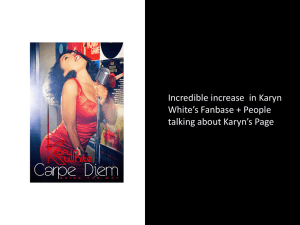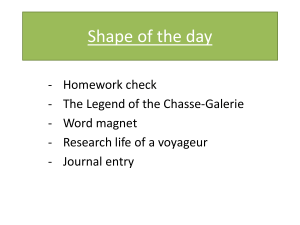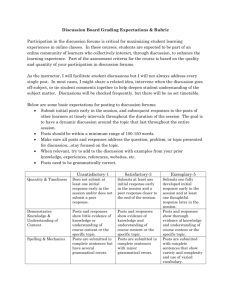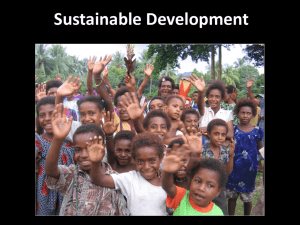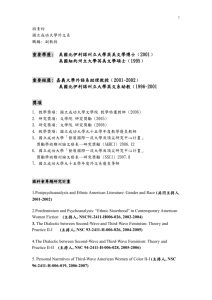Strategies for Problem Solving answers
advertisement
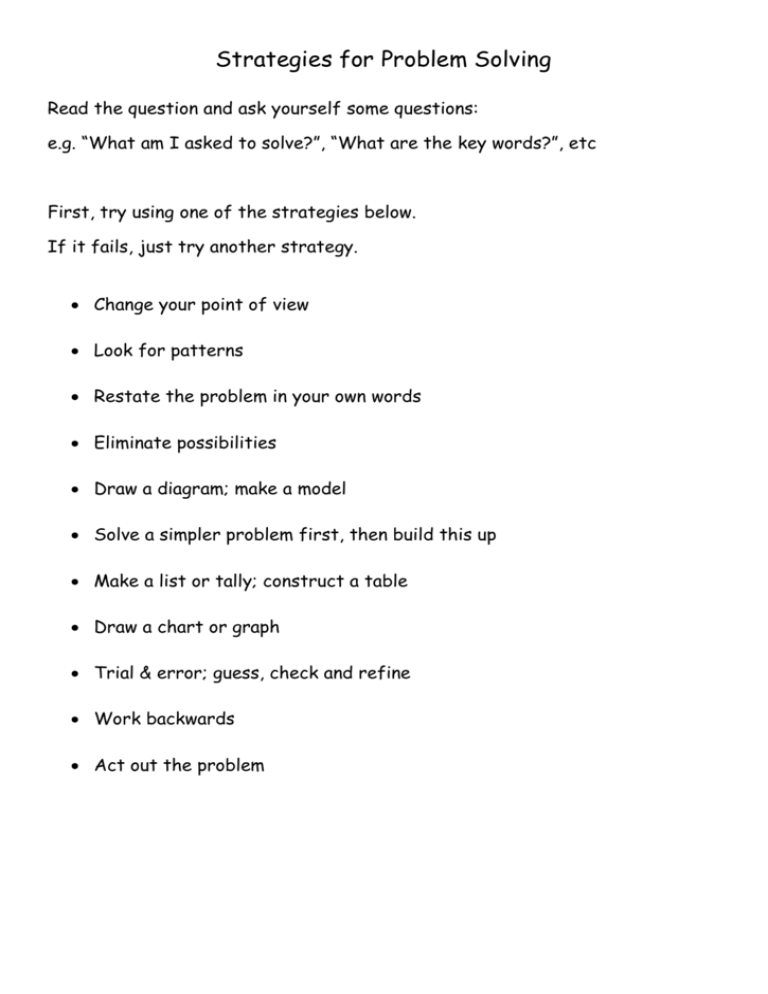
Strategies for Problem Solving Read the question and ask yourself some questions: e.g. “What am I asked to solve?”, “What are the key words?”, etc First, try using one of the strategies below. If it fails, just try another strategy. Change your point of view Look for patterns Restate the problem in your own words Eliminate possibilities Draw a diagram; make a model Solve a simpler problem first, then build this up Make a list or tally; construct a table Draw a chart or graph Trial & error; guess, check and refine Work backwards Act out the problem Group 1 - Guess, check & refine 1. The sum of two numbers is 15 and their product is 56. Find the two numbers. Answer: 7 & 8 2. Su-Lin is four years older than Mark. Twice Su-Lin’s age plus five times Mark’s age is equal to 64. What are the ages of Su-Lin and Mark? Answer: Su-Lin is 12, Mark is 8 3. A farmer has some chickens and cows. He counted 12 heads and 34 legs altogether, How many cows are there? Answer: 5 cows 4. Two 2-digit numbers are made from the digits 1, 2, 3 and 4 (with no digit being used more than once). What numbers would produce (a) the smallest product? (b) the largest product? (c) a product closest to 700? Answer: (a) 13 & 24, (b) 43 & 52, (c) 13 & 54 5. Louie, Verity and three children went to the movies. The children were charged half price. If the total cost of the tickets was $52.50, how much did each adult ticket cost? Answer: $15 Group 2 - Make a list or tally; construct a table 1. How many two-digit numbers can be formed using the digits 0, 7 and 8 if (a) each digit can only be used once? (b) each digit can be used more that once? Answer: (a) 4 (b) 6 2. A new nation wishes to design a flag with three stripes and using the colours red, white and blue. How many different flags can they design? Answer: 6 different flags 3. Five people are waiting for a lift. When the lift arrived, there was only room for three people. How many different groups of three people could get in the lift? Answer: 10 4. A hotel refurbished some floors and need to make new door numbers from 200 to 249. How many 2s will be needed? Answer: 65 5. You have one $2 coin, one $1 coin, one 10 cent piece and one 5 cent piece in your wallet. How many different amounts of money can you make? Answer: 15 6. A shopkeeper has only seven 50c coins and fifteen 20c coins left in his till. In how many ways can he make up $3.40? Answer: 3 ways (using 2, 4 or 6 of the 50c coins) Group 3 - Solve a simpler problem first, then build this up 1. (a) At a committee meeting, there were 4 people in the room and they all shook hands once with each other. Find the total number of handshakes. (b) At another meeting, there were 10 people who all shook hands with each other once. Find this new total number of handshakes. Answer: (a) 6, (b) 43 2. (a) How many squares of any size are there altogether in this figure? (b) How many squares of any size are there on a chessboard? Answer: 14 Answer: 204 3. How many diagonals can be drawn in a (a) square (b) pentagon (5 sides) (c) hexagon (6 sides) (d) octagon (8 sides) Answer: (a) 2, (b) 5, (c) 9, (d) 20 4. A machine is producing a roll of grid paper 2 cm wide. On this grid paper are drawn squares with sides 1 cm. How many squares can be found if the grid has length of 100 cm? Answer: 299 2 cm Group 4 - Draw a diagram; make a model; Act it out 1. (a) Glen wants to make a line of posts 8 m long. If he places posts 1 m apart, how many posts will he need? (b) Greg uses 24 posts and places them 2 metres apart. How far will Greg’s posts stretch? (ignore the thickness of the posts) Answer: (a) 9, (b) 46 m 2. In a shuttle race, 5 flags are placed in a line 10 metres apart (with the first flag being 20 metres from the start) Kester runs and picks up the first flag and returns it to the start. Find the total distance that Kester runs to complete the race. Answer: 400 m 3. Jock decided to swim 10 km up Bega river without leaving the river. He swam 2 km every hour then floated on his back for 10 minutes. Each time he floated, the current dragged him back 1 km. How long did it take Jock to complete his swim? Answer: 10 hr 20 min 4. 3 white and 3 black counters are placed on a strip as shown below. You may move counters into empty adjacent squares and jump over ONE counter at a time into an empty square. What is the least number of moves required to shift the white counters to the spaces occupied by the black counters, and vice versa? Answer: 15 moves Group 5 - Look for a pattern 1. (a) 9 - 7 + 9 - 7 + 9 - 7 + 9 - 7 + 9 - 7 + 9 - 7 + 9 - 7 + 9 - 7 + 9 - 7 (b) 1 + 2 + 3 + 4 + 1 + 2 + 3 + 4 + 1 + 2 + 3 + 4 + 1 + 2 + 3 + 4 + 1 + 2 + 3 + 4 (c) 1 1 1 1 1 1 1 1 1 1 1 1 1 1 1 1 2 3 3 4 4 5 5 6 6 7 7 8 8 9 9 10 Answer: (a) 18, (b) 50, (c) 2 5 2. Find the sum of (a) 1 + 9 + 2 + 8 + 3 + 7 + 4 + 6 + 5 + 10 (ie. the sum from 1 to 10) (b) 1 + 2 + 3 + 4 + 5 . . . + 17 + 18 + 19 + 20 (c) 1 + 2 + 3 + 4 + 5 . . . + 97 + 98 + 99 + 100 Answer: (a) 55, (b) 210, (c) 5050 3. What is the greatest number of regions that a circle can be cut into using (a) 2 cuts (b) 3 cuts (c) 5 cuts Answer: (a) 4, (b) 7, (c) 16 4. By first finding 1 + 3, then 1 + 3 + 5, then 1 + 3 + 5 + 7 and looking for a pattern to emerge, find (a) 1 + 3 + 5 + 7 + 9 + 11 + 13 + 15 (b) 1 + 3 + 5 . . . + 97 + 99 + 101 Answer: (a) 225, (b) 10201 5. By first finding 12, then 112, then 1112 and looking for a pattern to emerge, find 111 111 1112 Answer: 12 345 678 987 654 321

